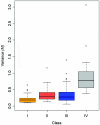Classification of human chromosome 21 gene-expression variations in Down syndrome: impact on disease phenotypes
- PMID: 17701894
- PMCID: PMC1950826
- DOI: 10.1086/520000
Classification of human chromosome 21 gene-expression variations in Down syndrome: impact on disease phenotypes
Abstract
Down syndrome caused by chromosome 21 trisomy is the most common genetic cause of mental retardation in humans. Disruption of the phenotype is thought to be the result of gene-dosage imbalance. Variations in chromosome 21 gene expression in Down syndrome were analyzed in lymphoblastoid cells derived from patients and control individuals. Of the 359 genes and predictions displayed on a specifically designed high-content chromosome 21 microarray, one-third were expressed in lymphoblastoid cells. We performed a mixed-model analysis of variance to find genes that are differentially expressed in Down syndrome independent of sex and interindividual variations. In addition, we identified genes with variations between Down syndrome and control samples that were significantly different from the gene-dosage effect (1.5). Microarray data were validated by quantitative polymerase chain reaction. We found that 29% of the expressed chromosome 21 transcripts are overexpressed in Down syndrome and correspond to either genes or open reading frames. Among these, 22% are increased proportional to the gene-dosage effect, and 7% are amplified. The other 71% of expressed sequences are either compensated (56%, with a large proportion of predicted genes and antisense transcripts) or highly variable among individuals (15%). Thus, most of the chromosome 21 transcripts are compensated for the gene-dosage effect. Overexpressed genes are likely to be involved in the Down syndrome phenotype, in contrast to the compensated genes. Highly variable genes could account for phenotypic variations observed in patients. Finally, we show that alternative transcripts belonging to the same gene are similarly regulated in Down syndrome but sense and antisense transcripts are not.
Figures





Similar articles
-
Mouse models of Down syndrome: how useful can they be? Comparison of the gene content of human chromosome 21 with orthologous mouse genomic regions.Gene. 2003 Oct 30;318:137-47. doi: 10.1016/s0378-1119(03)00769-8. Gene. 2003. PMID: 14585506
-
Primary and secondary transcriptional effects in the developing human Down syndrome brain and heart.Genome Biol. 2005;6(13):R107. doi: 10.1186/gb-2005-6-13-r107. Epub 2005 Dec 16. Genome Biol. 2005. PMID: 16420667 Free PMC article.
-
Chromosome 21 and down syndrome: from genomics to pathophysiology.Nat Rev Genet. 2004 Oct;5(10):725-38. doi: 10.1038/nrg1448. Nat Rev Genet. 2004. PMID: 15510164 Review.
-
Dosage-dependent over-expression of genes in the trisomic region of Ts1Cje mouse model for Down syndrome.Hum Mol Genet. 2004 Jul 1;13(13):1333-40. doi: 10.1093/hmg/ddh154. Epub 2004 May 11. Hum Mol Genet. 2004. PMID: 15138197
-
Mental retardation in Down syndrome: from gene dosage imbalance to molecular and cellular mechanisms.Neurosci Res. 2007 Dec;59(4):349-69. doi: 10.1016/j.neures.2007.08.007. Epub 2007 Aug 15. Neurosci Res. 2007. PMID: 17897742 Review.
Cited by
-
Disruption of super-enhancer-driven tumor suppressor gene RCAN1.4 expression promotes the malignancy of breast carcinoma.Mol Cancer. 2020 Aug 8;19(1):122. doi: 10.1186/s12943-020-01236-z. Mol Cancer. 2020. PMID: 32771023 Free PMC article.
-
Down syndrome and DYRK1A overexpression: relationships and future therapeutic directions.Front Mol Neurosci. 2024 Jul 24;17:1391564. doi: 10.3389/fnmol.2024.1391564. eCollection 2024. Front Mol Neurosci. 2024. PMID: 39114642 Free PMC article. Review.
-
The genomic and transcriptomic landscape of a HeLa cell line.G3 (Bethesda). 2013 Aug 7;3(8):1213-24. doi: 10.1534/g3.113.005777. G3 (Bethesda). 2013. PMID: 23550136 Free PMC article.
-
Genome-wide expression analysis in Down syndrome: insight into immunodeficiency.PLoS One. 2012;7(11):e49130. doi: 10.1371/journal.pone.0049130. Epub 2012 Nov 14. PLoS One. 2012. PMID: 23155455 Free PMC article.
-
Identifying Patients with Atrioventricular Septal Defect in Down Syndrome Populations by Using Self-Normalizing Neural Networks and Feature Selection.Genes (Basel). 2018 Apr 12;9(4):208. doi: 10.3390/genes9040208. Genes (Basel). 2018. PMID: 29649131 Free PMC article.
References
Web Resources
-
- Eleanor Roosevelt Institute: Chromosome 21 Gene Function and Pathway Database, http://chr21db.cudenver.edu/
-
- GenBank, http://www.ncbi.nlm.nih.gov/Genbank/ (for accession numbers in tables 5–8)
-
- Gene Expression Omnibus (GEO), http://www.ncbi.nlm.nih.gov/geo/ (for accession number GSE6408)
-
- Max Planck Institute: Chromosome 21 Gene Catalog Based on the New AGP File July 2002, http://chr21.molgen.mpg.de/chr21_catalogs/chr21_mar_2002.html
-
- NCBI Entrez, http://www.ncbi.nlm.nih.gov/gquery/gquery.fcgi (for accession numbers L13852 and AB000468)
Publication types
MeSH terms
Associated data
- Actions
- Actions
- Actions
LinkOut - more resources
Full Text Sources
Other Literature Sources
Medical
Molecular Biology Databases

